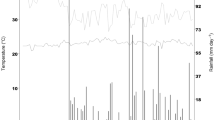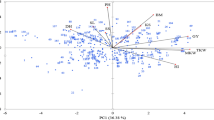Abstract
The present work aimed to study the genotype by environment interaction for nine important agronomic traits as a support for the indication of common bean cultivars for the Southern region of Brazil, identifying cultivars that possess high adaptability/stability. We carried out 25 field trials, in the rainy and dry sowing seasons, at different locals in the states of Paraná and Santa Catarina, from 2008 to 2010. The trials included 17 cultivars. Data were obtained for agronomic traits and subjected to variance analyses, and to adaptability and stability analyses according to the Nunes method. The genotype by environment interaction is important for different agronomic traits. There is genetic variation among cultivars and it was identified a different number of superior cultivars for each trait. Considering the means and adaptability and stability scores, 88% of the cultivars were superior for rust, 53% for anthracnose, 41% for grain yield, plant architecture and cycle, 30% for fusarium wilt and lodging, and 18% for angular leaf spot and common bacterial blight. For some of these traits, like angular leaf spot, common bacterial blight, fusarium wilt and lodging, it is necessary to intensify the efforts to provide more cultivars with high resistance or tolerance level, adaptability and stability. BRS Esplendor, a black-seeded cultivar, CNFC 10431 and BRS Sublime, both carioca-seeded cultivars, presented superiority for six of nine traits, being indicated to be used in the Southern region of Brazil. Other cultivars presented advantages for fewer traits and must be used in environments which these traits present greater importance.


Similar content being viewed by others
Abbreviations
- G × E:
-
Genotype by environment interaction
- Zi :
-
Adaptability parameter for each cultivar
- CVi :
-
Stability parameter for each cultivar
- SA:
-
Selective accuracy
References
Alzate-Marin AL, Sartorato A (2004) Analysis of the pathogenic variability of Colletotrichum lindemuthianum in Brazil. Ann Rep Bean Improv Coop 47:241–242
Cargnelutti Filho A, Storck L, Ribeiro ND (2009) Medidas da precisão experimental em ensaios com genótipos de feijão e de soja. Pesquisa Agropecuária Brasileira 44:1225–1231
Cochran WG (1954) The combination of estimates from different experiments. Biometrics 10:101–129
Cruz CD (2013) GENES—a software package for analysis in experimental statistics and quantitative genetics. Acta Sci Agron 35:271–276
Damasceno e Silva KJ, Souza EA, Ishikawa FH (2007) Caracterization of Colletotrichum lindemuthianum isolates from the State of Minas Gerais. J Phytopathol 151:241–247
Damasceno e Silva KJ, Souza EA, Sartorato A, Freire CNS (2008) Pathogenic variability of isolates of Pseudocercospora griseola, the cause of common bean angular leaf spot, and its implications for resistance breeding. J Phytopathol 156:602–606
Del Peloso MJ, Melo LC, Pereira HS, Faria LC, Diaz JLC, Wendland A (2009) Cultivares de feijoeiro comum desenvolvidas pela Embrapa. In: Fanceli AL (ed) Feijão: Tópicos especiais de manejo, 2nd edn. ESALQ/USP/LPV, Piracicaba
Feijão: dados conjunturais do feijão (área, produção e rendimento)—Brasil—1985 a 2013 (2014). http://www.cnpaf.embrapa.br/apps/socioeconomia/index.htm. Accessed May 2014
Gonçalves JGR, Chiorato AF, Perina EF, Carbonell SAM (2009) Estabilidade fenotípica em feijoeiro estimada por análise ammi com genótipo suplementar. Bragantia 68:863–871
HS Pereira, Costa AF, Melo LC, Del Peloso MJ, Faria LC, Wendland A (2013) Interação entre genótipos de feijoeiro e ambientes no Estado de Pernambuco: estabilidade, estratificação ambiental e decomposição da interação. Semina, Ciências Agrárias 34:2603–2614
Melo LC (2009) Procedimentos para condução de ensaios de valor de cultivo e uso em feijoeiro-comum. Embrapa Arroz e Feijão (Embrapa Arroz e Feijão, Série Documentos, Santo Antônio de Goiás, p 239
Melo LC, Santos PG, Faria LC, Diaz JLC, Del Peloso MJ, Rava CA, Costa JGC (2007) Interação com ambientes e estabilidade de genótipos de feijoeiro-comum na Região Centro-Sul do Brasil. Pesquisa Agropecuária Brasileira 42:715–723
Nunes JAR, Ramalho MAP, Abreu AFB (2005) Graphical method in studies of adaptability and stability of cultivars. Ann Rep Bean Improv Coop 48:182–183
Pereira HS, Melo LC, Faria LC, Diaz JLC, Del Peloso MJ, Costa JGC, Wendland A (2009a) Stability and adaptability of carioca common bean genotypes in states of the central South Region of Brazil. Crop Breed Appl Biotechnol 9:181–188
Pereira HS, Melo LC, Faria LC, Del Peloso MJ, Costa JGC, Rava CA, Wendland A (2009b) Adaptabilidade e estabilidade de genótipos de feijoeiro-comum com grãos tipo carioca na Região Central do Brasil. Pesquisa Agropecuária Brasileira 44:29–37
Pereira HS, Almeida WM, Melo LC, Faria LC, Wendland A, Del Peloso MJ, Magaldi MCS (2012) Influência do ambiente em cultivares de feijoeiro-comum em cerrado com baixa altitude. Bragantia 71:165–172
Pimentel-Gimes FP (2000) Curso de estatística experimental. Editora Nobel, São Paulo
Pontes Junior VA, Pereira HS, Melo LC, Del Peloso MJ, Faria LC, Wendland A, Ferreira SB (2012) Productive potential and interaction of elite bean lines with environments in the Central Cerrado of Brazil. Crop Breed Appl Biotechnol 12:8–16
Resende MDV, Duarte JBD (2007) Precisão e controle de qualidade em experimentos de avaliação de cultivares. Pesquisa Agropecuária Tropical 37:182–194
Ribeiro T, Esteves JAF, Silva DA, Gonçalves JGR, Carbonell SAM, Chiorato AF (2016) Classification of Colletotrichum lindemuthianum races in differential cultivars of common bean. Acta Sci Agron 38:179–184
Sartorato A (2002) Identification of phaeoisariopsis griseola pathotypes from five states in Brazil. Fitopatologia Brasileira 27:78–81
Souza TLPO, Ragagnin VA, Sanglard DA, Moreira MA, Barros EG (2007) Identification of Races of Selected Isolates of Uromyces appendiculatus from Minas Gerais (Brazil) Based on the new international classification system. Trop Plant Pathol 32:104–109
Torga PP, Melo PGS, Pereira HS, Faria LC, Del Peloso MJ, Melo LC (2013) Interaction of common bean cultivars of the black group with years, locations and sowing seasons. Euphytica 189:239–248
Zimmermann FJP (2004) Estatística aplicada à pesquisa agrícola. Embrapa Arroz e Feijão, Santo Antônio de Goiás
Acknowledgements
The authors are thankful to Embrapa Arroz e Feijão by the funds necessary to undergo this research and to Conselho Nacional de Desenvolvimento Tecnológico (CNPq) for concession of grants to Helton S. Pereira, Adriane Wendland, Thiago Lívio P.O. Souza and Leonardo C. Melo.
Author information
Authors and Affiliations
Corresponding author
Rights and permissions
About this article
Cite this article
Pereira, H.S., Faria, L.C., Wendland, A. et al. Genotype by environment interaction for disease resistance and other important agronomic traits supporting the indication of common bean cultivars. Euphytica 214, 12 (2018). https://doi.org/10.1007/s10681-017-2093-z
Received:
Accepted:
Published:
DOI: https://doi.org/10.1007/s10681-017-2093-z




